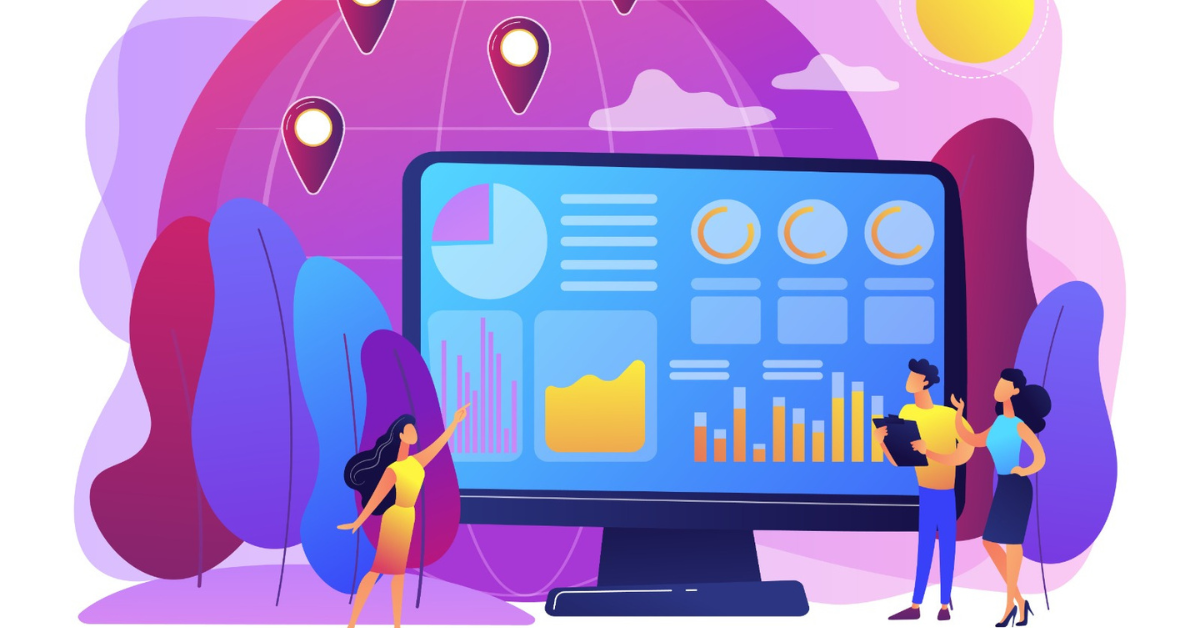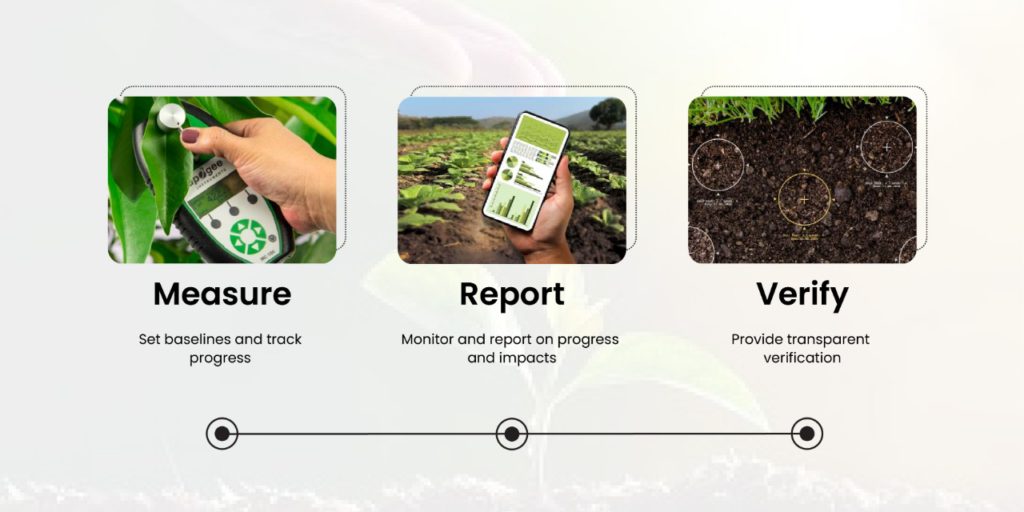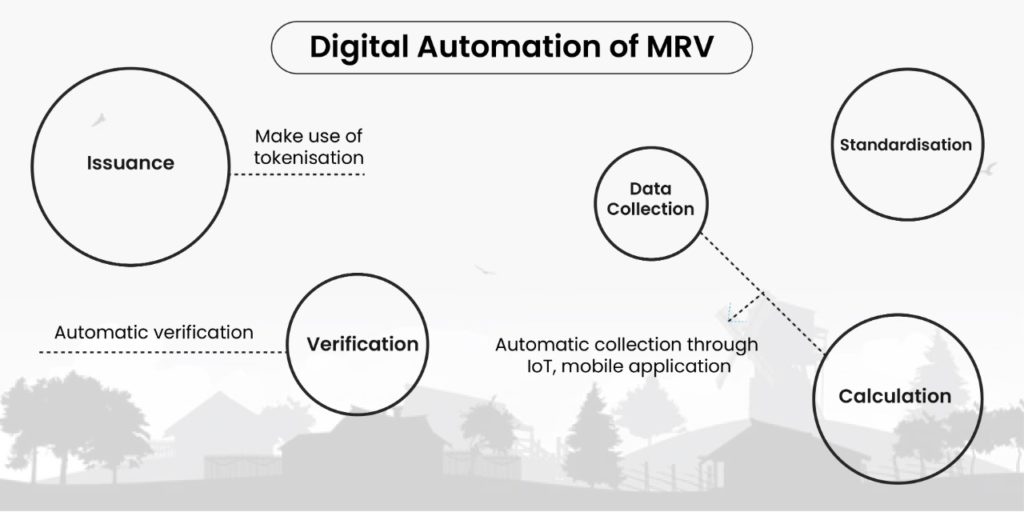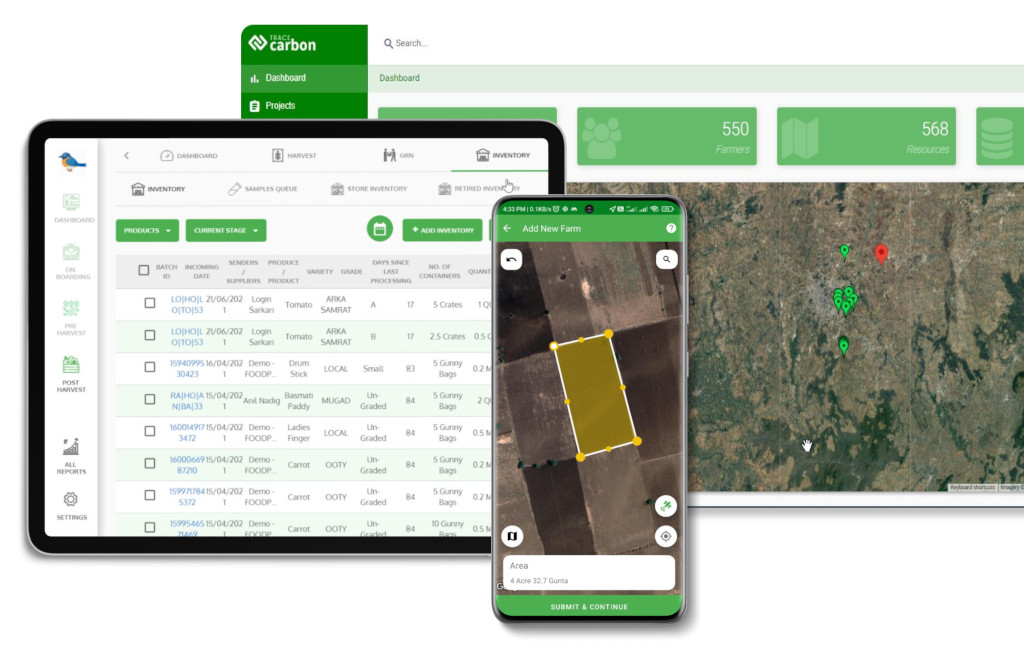Contact: +91 99725 24322 |
Menu
Menu
Quick summary: Explore the future of sustainability with Digital MRV Systems. Dive into the world of advanced monitoring, efficiency, and tech-driven solutions for emission reduction projects. Discover how digital innovation is reshaping the landscape of carbon offset initiatives.

Welcome to the world of Digital MRV (Monitoring, Reporting and Verification) Systems, where cutting edge technology meets environmental stewardship. In an era where sustainability and accountability are at the forefront of global concerns, Digital MRV systems have emerged as powerful tools to drive positive change.
Digital MRV systems harness the power of digitalization, data analytics and real-time monitoring to transform how we measure, report and verify environmental data. Whether you are a business striving to reduce your carbon footprint or an organization committed to meeting stringent emission targets. Digital MRV systems are your allies in the quest for a greener and sustainable future.
Join us in this journey as we explore the intricacies, benefits and transformative potential of Digital MRV in our quest to protect the planet and combat climate change.
Do you know that excel worksheets, pdfs still rule the Carbon offset market? Verification and accuracy are very critical in validating Carbon offsets to generate carbon credits in carbon markets.
Several countries want to participate in carbon markets to address the problems on climate change. More than two thirds of countries are planning to use carbon markets to meet their NDCs to the Paris agreement. Some countries are developing digital infrastructures to ensure carbon reductions are accurately tracked and accounted for. Carbon markets help to mobilize the resources with reduced costs to help companies transit to a low carbon economy.
It is estimated that trading in carbon credits can reduce the cost of implementing NDCs by $250 billion by 2030.
Digital technologies can successfully reduce the global GHGs through carbon markets. They can keep the verified data secure and ensure that reductions are accurately racked and recorded.
Monitoring, Reporting and Verification (MRV) of reductions in greenhouse gas emissions is the cornerstone of carbon markets. MRV is a process of measuring the emission reductions of a specific mitigation activity and report the findings to an accredited third party and finally verify the reductions so that they can be certified, and credits can be issued.
According to SustainCert, with Manual verification, one officer can verify 100-150 projects a year, with DMRV, one officer can verify 10 projects a day!
The importance of MRV is to collect and evaluate the information or data available on management of GHG emissions. Currently these processes are time-consuming, cumbersome with manual information or excels or in purpose surveys. Today, digital technologies streamline the data collection and bring in process and quality control in the MRV process. Companies can use MRV systems and processes to easily transit to decarbonization pathways.
Digitization of MRV makes carbon markets to function better and the simplification of the processes will enhance efficiency in these markets. Such systems promote transparency, accountability and trust between the stakeholders and provide assurance globally that the efforts are yielding results in the fight against climate change. This in turn facilitates climate finance and carbon markets. These systems also help when investors, carbon credit buyers demand higher level of stringency in disclosures and the impact reporting. The latest advances in digital technologies in terms of Distributed Ledger technologies, IoT sensors and satellite imaging help in capturing data that are accurate and reliable.

DMRV systems establish the basic requirements by ensuring accuracy, consistency, traceability and integrity of the mitigation outcome data throughout the MRV process. This can then serve as the basis for certification of such systems by independent verification and validation entities. This reduces transaction costs and time to market hastening the issue of carbon credits.
MRV has been using tools like spreadsheets, GHG inventory software systems, Life cycle inventory databases and LCA software, Emission factors databases, Remote sensing, Emission monitoring systems and online reporting and Registries, the next-gen MRV systems include knowledge base and standardized systems that can be more actively integrated with climate change strategies and solutions.

The end-to-end digitalization of MRV entails use of digital technologies and processes to automate collection of data, report GHG emissions and generate the mitigation outcomes to improve the functioning of carbon markets. These systems can be connected to national or international registries and the tradable outcomes can be tokenized by use of smart contracts.
Automated data collection is done using AI, machine learning, satellite imagery, smart sensors, Blockchain, IoT and drones. The MRV system integrates these technologies into a single system using common standards for data exchange and APIs to ensure compatibility and interoperability across various systems. Technology and data management tools are used to quantify, communicate and authenticate the results in real-time. This improves the speed, consistency and accuracy of reporting and also reduces costs, thereby increasing scalability. This data is captured on blockchain ledgers which are time-stamped and tamper proof, assuring the security of data.
These systems allow project implementers to monitor the data and connect it to a reporting and verification system. This helps international bodies to oversee reporting and verification. MRV systems can generate automatic reports on GHG emissions, and the emissions data can be analysed and reported. Deviations can be flagged relative to activities in the baseline scenarios. Algorithms can be programmed to ensure a repetitive process for reporting to be reproduced in different formats.
Verification and validation can be undertaken to ensure that it follows the GHG emission reporting standards. The GHG emission reports can be verified through remotely making the process faster and cheaper. Quality control can also be a pre-requisite to ensure screening of data.
This involves leveraging digital technology and cutting-edge tools to monitor and track the progress of carbon offset projects. These projects are essential in mitigating greenhouse gas emissions and combating climate change by reducing, avoiding or capturing carbon dioxide from the atmosphere.
At its core, digital monitoring aims to ensure the accuracy and transparency of carbon offset initiatives. It involves the systematic collection of data and information pertaining to emissions, reductions and overall performance of these projects.
Real-time Data Collection
Digital monitoring systems continuously collect data from various sources within a carbon offset project. The project performance data can be collected in real-time using sensors, smart meters, satellite data, smartphone applications and other tools. This data can include information about sustainable practices followed, reforestation efforts, energy consumption and renewable energy generation.
Data Analysis
Once collected, the data is subjected to rigorous analysis. The data can be collected, recorded and analysed based on the performance parameters. The analytic tools process and interpret the information, allowing project managers to gain insights into project performance.
Digital monitoring plays a crucial role in verifying emission reductions. It provides the means to quantify how much carbon dioxide and other greenhouse gases have been prevented from entering the atmosphere due to the project’s activities. The Mitigation action reports from certified systems can be verified faster at less costs. The verification tools can be built into the system through dedicated user profiles.
Automatic reports can be generated based on the methodology adopted for mitigation. This data can be monitored, analysed and reported. One of the key advantages of digital monitoring is its ability to generate accurate and transparent reports. These reports are often required for regulatory compliance and certification processes.
DMRV is paramount for the developers of carbon offset projects. These developers are tasked with the critical mission of reducing greenhouse gas emissions and contribute to fight against climate change. DMRV systems streamline the process, enhance accuracy and ultimately ensure success of the project.
DMRV tools and technologies empower these carbon project developers to make a meaningful impact on carbon reduction. By optimizing their DMRV processes, developers can enhance their project’s effectiveness, reduce costs and contribute to a more sustainable future for our planet.
Harnessing the power of DMRV in nature-based carbon offsets signifies a technologically and scientifically robust approach to carbon sequestration and emission reduction in natural ecosystems. It strengthens the role of nature-based solutions in mitigating climate change, preserving biodiversity and promoting sustainability. This concept is vital for achieving carbon neutrality and fostering a resilient and sustainable future.
Manual data measurement is error prone and there is insufficient data collected. The inputting process is cumbersome and time consuming.
The MRV systems increase the accuracy of recorded data with digital technologies and are able to collect, process and store the data in digital ledgers. This saves time and lowers risk of data loss. The real-time data collection reduces the need for sampling and accuracy is maintained.
MRV systems can automatically analyse the data, process and report the results in customized formats. The unit conversions, calculations and any statistical analysis used by the methodology can be programmed into the system. This eliminates errors. Also quality deviations can be monitored and duly reported. Standardized report formats can be built into the system which can be seamlessly integrated with other systems for the benefit of other stakeholders.
Verification of data can be time consuming and costly. Large volumes of data that needs to be scrutinized can be avoided with digital technologies that streamline the entire process. They allow for remote verification and allow the improvement of accuracy and data quality. The overall time required to verify GHG inventories, and the mitigation activities are reduced and cost effective.
Remote verification is facilitated that saves time. The robustness of the system ensures credibility to the data claims. Mitigation outcomes from a MRV system can claim a higher premium on account of their credibility and integrity in carbon markets.
Tech driven emission reduction verification represents a significant shift in how we approach and ensure the credibility of emission reduction claims. This signifies the role that advanced technology and digital tools play in verifying and validating the effectiveness of strategies aimed at reducing greenhouse gas emissions.
Tech-driven verification relies on monitoring technologies such as remote sensing, satellite imagery, IoT and drones. Advanced data analytics and AI are used to process the vast amounts of data collected from monitoring devices. Tech-driven verification also offers continuous monitoring of emission sources. Digital records and blockchain technology are often integrated into tech-driven verification systems to ensure transparency and accountability. Remote monitoring reduces the need for physical site visits. Tech-driven systems can be scaled to accommodate a growing number of emission reduction projects.
Climate action is about trust and blockchain provides that transformational change.
Blockchain technology is suitable positioned to scale the voluntary carbon markets. Blockchain based DMRV systems can provide real-time monitoring, reporting and validation of data. They help to optimize workflows and streamline processes bringing in credibility, accountability and transparency into the process. They also open carbon trade through asset tokenization. As blockchain can create records that are more credible and resistant to frauds, they can go beyond just measurement, reporting and verification. Through sustainable reporting they can help the world to inch towards the 1.5˚C goal.
Verra and Gold standards are pioneers in qualifying the credibility of carbon offsets and they are scaling carbon markets with the aid of DMRV solutions. Verra plans to have operational DMRV platforms within a year starting with projects in renewable energy and forestry. An internal working group collaborates with many stakeholders to develop protocols and frameworks to enable third parties to develop DMRV platforms for use in various projects.
Trace Carbon – TraceX’s sustainability and carbon management solution plays a crucial role in enhancing the effectiveness and reliability of carbon offset projects, particularly those based on nature-based solutions. The DMRV tool enables real-time collection of data related to carbon sequestration and emissions in natural ecosystems. The accuracy offered ensures alignment with established standards and methodologies. DMRV solutions provide continuous and automated monitoring capabilities. The tool also provides integration with remote sensing technologies. The data analytics process vast datasets and generate comprehensive reports and ensure transparency in carbon offset projects.
TraceX DMRV solution empowers project managers with real-time data, accuracy, comprehensive insights ensuring these projects fulfil their environmental, social and economic objectives.
In conclusion, Digital MRV systems represent a significant way in how we monitor, verify and report emissions and sustainability efforts. These advanced technologies offer unparalleled accuracy, real-time insights and the ability to manage climate and environmental initiatives with greater efficiency and effectiveness. As we face the urgent challenge of mitigating climate change, these systems are just not tools, they are essential instruments in our global efforts to reduce greenhouse gas emissions, protect natural ecosystems and build a sustainable future.
Embracing Digital MRV is not merely an option but a necessity to track progress, drive meaningful change and achieve our climate and sustainability goals.
